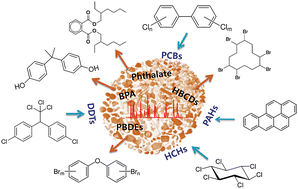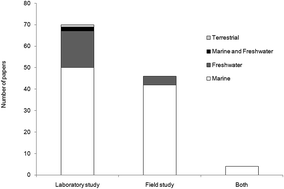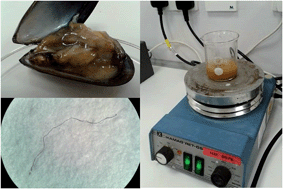Themed collection Microplastics in the environment

Improving microplastics source apportionment: a role for microplastic morphology and taxonomy?
Paul Helm discusses the need for a more detailed level of classification to aid in identifying source contributions of microplastics, providing direction on the implementation of management activities to reduce the occurrence of microplastics in the environment and enabling monitoring of the effectiveness of those actions.

Anal. Methods, 2017,9, 1328-1331
https://doi.org/10.1039/C7AY90016C
Analytical challenges associated with the determination of microplastics in the environment
Rob Hale considers the significant analytical challenges posed through the use of plastics and the resulting small fragments they yield – microplastics – which are a major contaminant of concern for both human health and ecosystems worldwide.

Anal. Methods, 2017,9, 1326-1327
https://doi.org/10.1039/C7AY90015E
On the harmonization of methods for measuring the occurrence, fate and effects of microplastics
Welcome to this Analytical Methods themed issue on microplastics in the environment, guest edited by Chelsea M. Rochman, Fiona Regan and Richard C. Thompson. The editors hope that this editorial will facilitate discussions that lead toward harmonized methods that are informed by hypotheses, and ultimately produce data that can be synthesized and used to inform effective local and global policies that prevent and mitigate microplastics.

Anal. Methods, 2017,9, 1324-1325
https://doi.org/10.1039/C7AY90014G
The human dimension: how social and behavioural research methods can help address microplastics in the environment
The present paper illustrates the breadth of research methods in the Social and Behavioural Sciences and how these may be applied to the issue of environmental microplastics.

Anal. Methods, 2017,9, 1404-1411
https://doi.org/10.1039/C6AY02647H
A review of microscopy and comparative molecular-based methods to characterize “Plastisphere” communities
A summary of molecular and visualization techniques to characterize life in the Plastisphere and compare corresponding datasets through the VAMPS website.

Anal. Methods, 2017,9, 2132-2143
https://doi.org/10.1039/C7AY00260B
Methods of analysing chemicals associated with microplastics: a review
Analytical approaches and methods applied to the chemical analysis of microplastics and plastic debris from the marine environment were reviewed.

Anal. Methods, 2017,9, 1361-1368
https://doi.org/10.1039/C6AY02971J
A review of analytical techniques for quantifying microplastics in sediments
In this review the analytical techniques for measuring microplastics in sediment have been evaluated.

Anal. Methods, 2017,9, 1369-1383
https://doi.org/10.1039/C6AY02707E
Some problems and practicalities in design and interpretation of samples of microplastic waste
Improved design of sampling microplastic waste is necessary. Important problems are identified and suggestions for improvements are made.

Anal. Methods, 2017,9, 1332-1345
https://doi.org/10.1039/C6AY02641A
Identification methods in microplastic analysis: a review
Microplastics have become a major global environmental issue in recent decades due to their ubiquity in the oceans, bioavailability and ability to carry toxic chemicals.

Anal. Methods, 2017,9, 1384-1391
https://doi.org/10.1039/C6AY02558G
Incorporating citizen science to study plastics in the environment
Plastic marine debris is a global problem, but due to its widespread and patchy distribution, gathering sufficient samples for scientific research is challenging with limited ship time and human resources.

Anal. Methods, 2017,9, 1392-1403
https://doi.org/10.1039/C6AY02716D
Sampling, isolating and identifying microplastics ingested by fish and invertebrates
Microplastic debris (<5 mm) is a prolific environmental pollutant, found worldwide in marine, freshwater and terrestrial ecosystems. This review assesses the numerous different methods used to identify microplastics ingested by marine organisms.

Anal. Methods, 2017,9, 1346-1360
https://doi.org/10.1039/C6AY02415G
Extraction and identification of microplastic particles from secondary wastewater treatment plant (WWTP) effluent
A wastewater utility's attempt to optimize extraction and identification of microplastics underscores unique matrix-related challenges and interferences.

Anal. Methods, 2017,9, 1412-1418
https://doi.org/10.1039/C6AY02397E
A risk framework for tackling marine debris
Understanding plastic pollution from a systems perspective requires a way of conceptualizing sources, distribution and dynamics in the environment; identifying or quantifying impacts on wildlife, humans and other assets; and identifying and evaluating potential management responses.

Anal. Methods, 2017,9, 1429-1436
https://doi.org/10.1039/C6AY02934E
An automated approach for microplastics analysis using focal plane array (FPA) FTIR microscopy and image analysis
We present an automated approach to reduce the time demand currently needed for data analyses. We have developed a novel analysis pipeline, followed by image analysis with Python and Simple ITK image processing modules.

Anal. Methods, 2017,9, 1499-1511
https://doi.org/10.1039/C6AY02476A
A novel, density-independent and FTIR-compatible approach for the rapid extraction of microplastics from aquatic sediments
We present here a novel, density-independent, FTIR-compatible and inexpensive approach for extracting microplastics from aquatic sediments.

Anal. Methods, 2017,9, 1419-1428
https://doi.org/10.1039/C6AY02733D
First detection of seven phthalate esters (PAEs) as plastic tracers in superficial neustonic/planktonic samples and cetacean blubber
PAEs concentrations can serve as tracer of plastics ingestion by marine organisms.

Anal. Methods, 2017,9, 1512-1520
https://doi.org/10.1039/C6AY02674E
Validation of density separation for the rapid recovery of microplastics from sediment
Validation of the separation of secondary microplastics from sediment using numerous brine solutions in a rapid, reproducible, single stage technique.

Anal. Methods, 2017,9, 1491-1498
https://doi.org/10.1039/C6AY02542K
Novel method for the extraction and identification of microplastics in ocean trawl and fish gut matrices
This alternative microplastic extraction method employs ultrapure water, ultrasonication, and identification using complementary optical microscopy, SEM/EDS, FTIR, and RMS techniques.

Anal. Methods, 2017,9, 1479-1490
https://doi.org/10.1039/C6AY02396G
An approach for extraction, characterization and quantitation of microplastic in natural marine snow using Raman microscopy
Marine snow is a predominant form of sinking particulate carbon in the marine water column and represents a mechanism for transporting microplastics to the sea floor.

Anal. Methods, 2017,9, 1470-1478
https://doi.org/10.1039/C6AY02302A
Grab vs. neuston tow net: a microplastic sampling performance comparison and possible advances in the field
With the rapid evolution of microplastic research over several decades, there is an urgent need to compare methodologies for quantifying microplastic in aquatic environments.

Anal. Methods, 2017,9, 1446-1453
https://doi.org/10.1039/C6AY02387H
Quantifying ingested debris in marine megafauna: a review and recommendations for standardization
Plastic pollution has become one of the largest environmental challenges we currently face, but standardized reporting is required to meet critical research needs.

Anal. Methods, 2017,9, 1454-1469
https://doi.org/10.1039/C6AY02419J
Optimisation of enzymatic digestion and validation of specimen preservation methods for the analysis of ingested microplastics
Development of an effective, non-destructive enzymatic method to extract microplastics from newly sampled and archival specimen collections.

Anal. Methods, 2017,9, 1437-1445
https://doi.org/10.1039/C6AY02343F
Extracting DNA from ocean microplastics: a method comparison study
Molecular characterization of ocean plastic biofilms can shed light on the ecological implications of plastic pollution; here we provide detailed protocols and compare different DNA extraction methods applied to marine microplastics.

Anal. Methods, 2017,9, 1521-1526
https://doi.org/10.1039/C6AY03119F
About this collection
This themed issue, Guest Edited by Professors Fiona Regan (Dublin City University, UK), Chelsea Rochman (University of California Davis, USA) and Richard Thompson (Plymouth University, UK), highlights the outstanding work in microplastics analysis and provides insight into this emerging and important area of research.